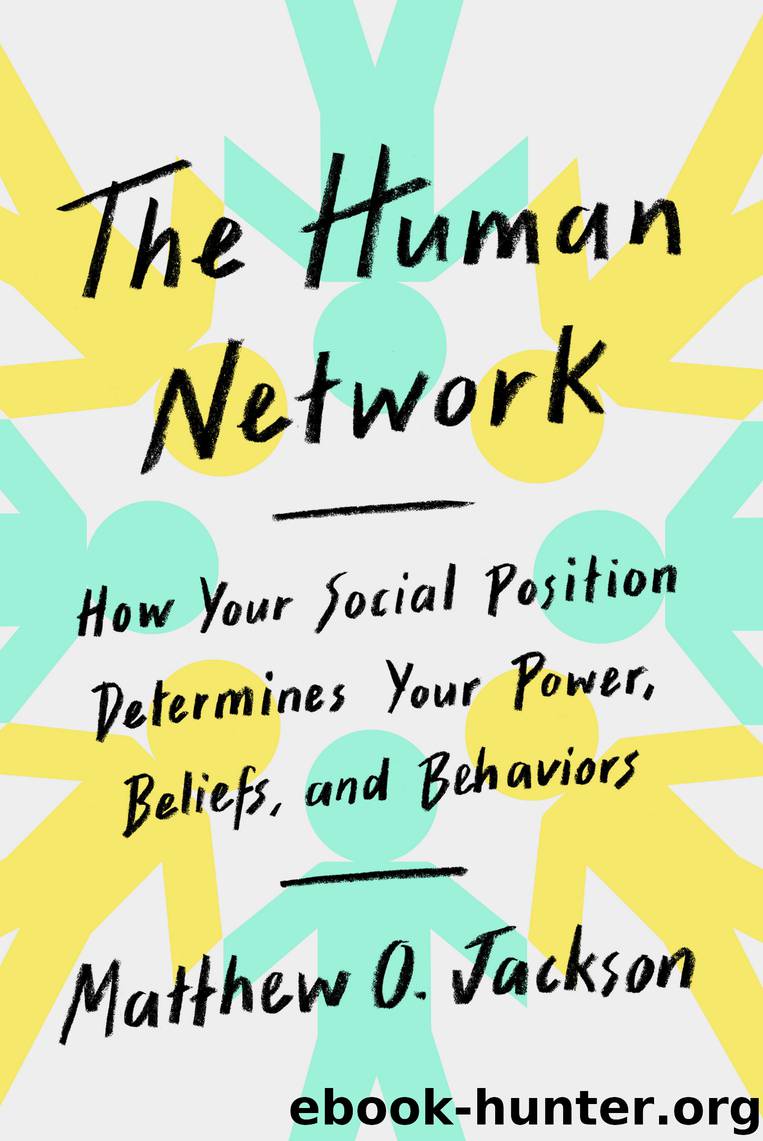Human Network : How Your Social Position Determines Your Power, Beliefs, and Behaviors (9781101871447) by Jackson Matthew O

Author:Jackson, Matthew O.
Language: eng
Format: epub
Publisher: Random House Digital
Published: 2019-03-04T16:00:00+00:00
Figure 7.3: Panel (a) an unbalanced network. Panel (b) a balanced network. The network in (a) is more efficient in having fewer links and having someone who has access to all the information in the network, but it can end up overreflecting the center person’s views.
We see an example of an unbalanced versus a balanced network in Figure 7.3. All of the unbalanced network passes through a single person. If that person places more weight on his or her own opinion than those of his or her friends (a natural tendency20), then that will be reflected back in the final beliefs. In contrast, the symmetry of the more balanced network means that nobody ends up driving the overall consensus that emerges.21 The unbalanced network can save on communication costs, as it offers one-stop shopping for information: each peripheral person only needs to talk to one person to get information about what everyone is thinking, which is why one might see such starlike networks emerge.22 But such unbalanced and centralized networks can end up with biased opinions.
Whom people pay attention to is something that has been extensively studied. For instance, in a series of studies in the 1940s and 1950s Paul Lazarsfeld examined how people formed their opinions. First was a study of 2,400 adults in Ohio during the months leading up to the 1940 presidential election. Lazarsfeld, together with two colleagues and a team of research assistants, interviewed a series of people repeatedly, and asked with whom they had talked, which media they were paying attention to, and what caused them to change their opinions whenever there was a switch.23 Lazarsfeld also was involved with a later study of eight hundred women in Decatur, Illinois, asking them how they formed opinions on a variety of topics, including consumer products.24 From these studies emerged a theory of “two-step communication” that was elaborated upon in a book by Elihu Katz together with Lazarsfeld. The two-step communication theory posits that there are people who operate as “opinion leaders”—mavens, as it were—who relay information gleaned from media to other people, “opinion followers.” A similar theory was the centerpiece of Malcolm Gladwell’s Law of the Few.25
Are there situations in which a society relies heavily on just one person’s opinion? It is not hard to find examples. Some have suggested that Robert Parker, a famous wine critic, held immense influence within the wine industry. It is hard to dispute that Parker was “the” wine critic for several decades.
The wine industry is one in which information from such critics is vital. More than thirty billion bottles of wine are consumed each year, produced by tens of thousands of wineries many of which ship all over world. The quality of a wine depends on local weather and soil conditions, as well as how the vines are handled, when the grapes are picked, and how the wine is made. Even the same winemaker working from the same vineyards may have substantial variation in the quality of a wine from one year to the next.
Download
This site does not store any files on its server. We only index and link to content provided by other sites. Please contact the content providers to delete copyright contents if any and email us, we'll remove relevant links or contents immediately.
| Anthropology | Archaeology |
| Philosophy | Politics & Government |
| Social Sciences | Sociology |
| Women's Studies |
Nudge - Improving Decisions about Health, Wealth, and Happiness by Thaler Sunstein(7460)
iGen by Jean M. Twenge(5326)
The Fire Next Time by James Baldwin(5199)
Adulting by Kelly Williams Brown(4437)
The Hacking of the American Mind by Robert H. Lustig(4265)
The Sports Rules Book by Human Kinetics(4213)
The Ethical Slut by Janet W. Hardy(4147)
Captivate by Vanessa Van Edwards(3762)
Mummy Knew by Lisa James(3582)
In a Sunburned Country by Bill Bryson(3451)
The Worm at the Core by Sheldon Solomon(3397)
Ants Among Elephants by Sujatha Gidla(3362)
Suicide: A Study in Sociology by Emile Durkheim(2946)
The Slow Fix: Solve Problems, Work Smarter, and Live Better In a World Addicted to Speed by Carl Honore(2911)
The 48 laws of power by Robert Greene & Joost Elffers(2890)
Humans of New York by Brandon Stanton(2742)
Handbook of Forensic Sociology and Psychology by Stephen J. Morewitz & Mark L. Goldstein(2636)
The Happy Hooker by Xaviera Hollander(2624)
The Tipping Point by Malcolm Gladwell(2613)
